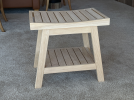Yep, like Robert said, Waterlox is a great finish. And repairs easier than poly. It's my preferred finish as well when I want a film finish.
That said, in the constantly wet environment, there is one particular way that it will be have very similar to a urethane finish: Once the film gets even the slighest 'break' in it, moisture will slowly work its way in, causing the wood to swell when it gets wet, then shrink when it dries. Over time, this repeated action will eventually cause the finish to begin to crack and peel ... just like any other film finish.
Spar varnishes — made for use on wooden parts on boats and watercraft — are the most elastic film finish. This allows them to 'flex' with this constant movement of the wood beneath it. But, while they'll hold up longer than a urathane or phenolic resin film finish, they too will eventually begin to crack and peel.
How long they will last depends on how much time passes before the first few tiny 'breaks' are created (e.g. nicks, dents, scratches from used, etc.) ... and then how often the shower gets used.
It all boils down to how you want the bench to look, and how much/little maintenance you want to do on it:
- Keep raw and let it gray naturally. You can lightly scrub it now and then to remove any mildew spots, if any start to form.
- Use a pure oil finish ... or an oil and wax finish ... and re-apply it as needed (every couple of months?).
- Use a more-easily repaired film finish like Waterlox Original and do mild spot sanding and reapplication when/where needed (1 or 2 times a year?)
Use a spar varnish and completely sand and refinish when needed (every 1 - 3 years?) (NOTE: Really good ones, like Epifanes, may be spot repairable similar to Waterlox. It's a phenolic-modified alklyd made from tung oil (also similar to Waterlox). You'd have to check out their product info. The ones found at HD and LWS are urethane-based spars though, so once they start to crack and peel, you have to completely sand them off before applying a new coat.)
Might also be worth looking into epoxies or fiberglass resin.
And, as Wiley pointed out, if you can't disassemble it, completely coat all the surfaces in a film finish, then reassemble it, this process of water absorption, swelling, then shrinking will occur very soon, and very fast. And make even quicker work of lifting/wreaking a film finish.
Hope this helps.
And the bench looks really sharp. Nice work!!

